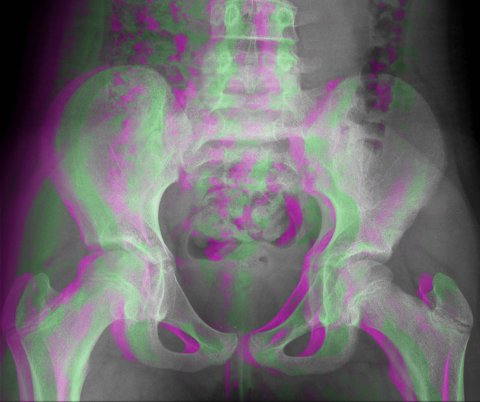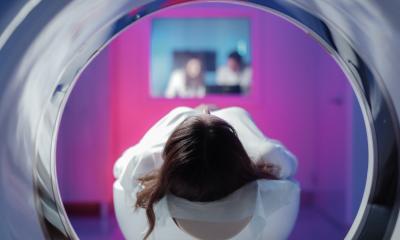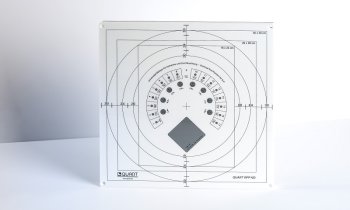News • Scattering suppression for imaging
'Autocorrect' feature to make X-rays safer for children
European photonics scientists have developed a new ‘autocorrect’ image processing algorithm to reduce X-ray scatter, meaning children can receive safer, high contrast, low dose X-rays.
Image source: Staff at the Department of Radiology, UC San Diego Health., X-ray of the pelvis of a 10 year old female - case 1 - anteroposterior, Anaglyph effect: HiE/Behrends
Clinicians will be able to take a low radiation, digital X-ray image - without the need for an anti-scatter grid - thanks to new innovative ‘scattering suppression software’. Developed by photonics scientists at the Warsaw University of Technology (WUT), working in collaboration with innovation incubator ACTPHAST 4.0 and medical imaging company Italray SRL, the new algorithm ‘auto corrects’ unclear, low dose digital X-rays to generate a higher-contrast image, meaning young children can receive safer scans.
When having an X-ray or CT scan, beams enter the body and ricochet around inside – or become ‘scattered’. Given that the scatter signal interferes with the primary contrast of the patient’s physical features such as bones or organs, this scattering process creates ‘noise’ and leads to a loss in image quality - making resulting X-rays appear blurred. The scatter, however can be counteracted with an ‘anti scatter grid’ – a metal plate made of lead strips to encourage parallel beams - improving the image contrast. But, this grid normally requires a higher dose of X-rays, and can therefore be dangerous to small children.
With over 660 million X-rays being recorded in Europe in 2008 they are a diagnostic test most of us are familiar with. X-rays can emit harmful ionizing radiation - high-energy particles that penetrate tissue to reveal internal organs and bone structures – which can damage DNA. While scientists have often sought to reduce this ionizing radiation, traditionally it has come at the expense of the type of detector and image resolution.

Image source: Staff at the Department of Radiology, UC San Diego Health., X-ray of the pelvis of a 10 year old female - case 1 - anteroposterior, Anaglyph effect: HiE/Behrends
The photonics scientists have been able to address the image quality problem as a result of scatter from the perspective of the acquired data and the digital image processing. Dr. Wojciech Krauze, project manager for the collaboration explains: “The partnership between ACTPHAST 4.0, Italray and WUT has looked at ways to reduce the amount of ‘noise’ – or the removal of errors - in final images. It works by minimising the scattering process by taking the original image and estimation of the scatter signal. By partially ‘reversing’ the scatter our digital image processing algorithm is able to reduce the amount of noise signal, essentially ‘autocorrecting’ the blurred image. The method is very fast: a physician taking the x-ray image of a patient obtains the corrected 'denoised' version instantly. The result is a ‘scatter grid quality’ image without the need for an actual anti scatter grid.”
The SME ‘incubator’ that helps existing and fledgling businesses with innovation partnership, ACTPHAST 4.0 provided the expertise in photonics to Italray. Partnering with the ‘one-stop shop’ digital incubator that provides open access to photonics innovation support for eligible European companies, Italray has seen ACTPHAST make a huge difference.
Peter Doyle, central outreach coordinator, said: “Many SMEs today do not have access to experts in the technical aspects of innovating with photonics. ACTPHAST made the difference in terms of access to photonics technical capabilities and expertise from within our network. We were able to help with the development of software which needed deep photonics expertise.
Companies that have never used photonics before look to ACTPHAST 4.0 to help them develop the photonics components for their next generation products. “We have worked with Italray to nurture their product and provide access to state-of-the-art technology platforms. ACTPHAST 4.0 links first-time users who would not normally use optics or photonics in their products (as well as those that are already established within the photonics industry) with bespoke prototyping solutions, tailoring their new product innovation to be fit for purpose in the modern digital economy,” said Doyle.
Source: ACTPHAST
06.01.2021











